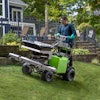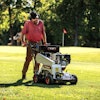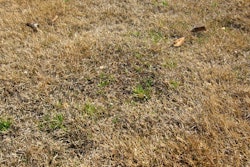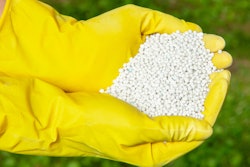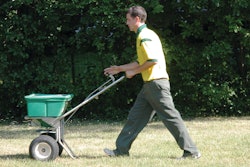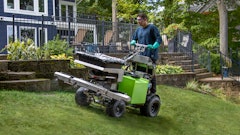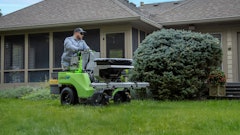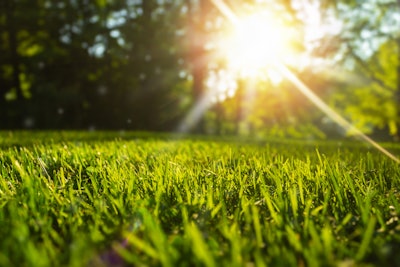
The summer season is right around the corner, and it’s important to keep our grass strong and healthy as the stressful heat of summer approaches. Below are some recommended summer lawn care tips for warm- or cool-season lawn.
1. Keep up summer mowing
Summer mowing gets even harder if you let the lawn get too tall. As the grass continues to grow taller, the lawn mower becomes harder to push. Keep the lawn at its appropriate height to reduce the amount of effort and time spent in the hot sun.
Below are the ideal summer mowing heights for a few various grass types. Keep in mind that specific grass brands may require a different mowing height.
- Bermudagrass: 0.5 to 1.5 inches
- Bluegrass: 2.5 to 3.5 inches
- Centipedegrass: 1.5 to 2.0 inches
- Fescue: 2.5 to 3.5 inches
- St. Augustinegrass: 2 to 4 inches
- Zoysiagrass (fine-bladed): 0.5 to 1.5 inches
- Zoysiagrass (coarse-bladed): 1 to 2 inches
A good rule of thumb is to never remove more than a third of the leaf blade at a time. If a larger amount is removed, the grass will stress and potentially turn brown for a short period of time.
Be sure to wait about three to five days between each mowing. One benefit of taller grass blades is that they provide more shade for the root system to stay cool and retain moisture during the hot summer days.
2. Use the right fertilizer
With rising outdoor temperatures comes increased soil temperatures and changing soil conditions. Grass needs different nutrients at this time compared to what it needed in the spring or fall.
The lawn will more than likely endure some form of stress from the summer heat. It’s important to feed the grass with the appropriate amount of nutrients to help out with this stressful period by using a summer lawn fertilizer.
Grass requires less nitrogen in the summer than it would in the spring when it’s coming out of dormancy and trying to green up. Nitrogen promotes new growth, which will not survive in the heat of the summer and the wrong fertilizer combined with excess sunlight during the summer can easily cause scorched spots in the yard.
3. Irrigation the lawn but don't over-irrigate
Warmer temperatures and more sunlight make it very tempting to water the lawn more often. This is not always recommended as waterlogged soils in warm climates are ideal environments for disease outbreaks.
Despite hot temperatures that occur during the summer, the lawn should only need about 1 inch of water on a weekly basis including rainfall. This is best accomplished with one or two waterings a week.
Water in the early mornings for longer periods of time, less frequently and take any rainfall into consideration. Watering the lawn in the early morning decreases the dew period. As a result, this also decreases the amount of time the grass blades are wet, which is a helpful disease management practice.
If you aren’t sure how to measure 1 inch of water, consider conducting an easy irrigation audit. If the lawn seems to become too warm or starts accumulating scorched, brown spots, consider adding a layer of top dressing to keep it shaded and cool.
4. Be cautious with weed control
Don’t make applications of any herbicides currently. This is especially true for cool-season grasses like fescues and bluegrass. If you do, be sure to spot treat each weed or consider hand-pulling them instead. Summer is the worst time for herbicide applications for most grass types. When temperatures reach or exceed 85 degrees Fahrenheit, herbicides will damage the grass.
It’s best to wait until it gets cooler before applying a post-emergent herbicide to any weeds in the yard. In the future, apply a preemergent herbicide in the spring to reduce summer weeds and be sure to apply a pre-emergent herbicide in the fall to keep fall and winter weeds out.
If temperatures are consistently below 85 degrees F, it’s generally safe to apply post-emergent herbicides for any summer annual and perennial weeds. However, we suggest waiting until it gets closer to the fall season. If temperatures are low one day and exceed 85 degrees in the following days, the grass is still vulnerable to damage from the herbicide.
A few common weeds you might see during the summer include knotweed, spurge, lespedeza, crabgrass, goosegrass, dallisagrass, nutsedge and sandspur depending on the grass type.
5. Watch out for insects or insect damage
This time of year is the absolute worst time for insect invasions. Bugs like fire ants or mosquitos aren’t the only ones to watch out for—there are a lot of insects that can cause severe damage to the lawn.
Some of the most common summer insects include chinch bugs, grub worms, mole crickets, billbugs and spittlebugs.
Symptoms of an insect invasion differs from insect to insect. For example, signs of a chinch bug infestation include a spotty pattern of patchy grass that almost looks like drought damage.
A common way to identify a grub worm problem, on the other hand, is by seeing an increase in burrowing mammals, like moles, that are feeding on them. You can also dig a little in the lawn and spot them that way.
June is about the time to apply a preventative insecticide for grub worms because the adult beetles like the Japanese beetle or May/June beetle start flying around and drop eggs at this time.
A mole cricket infestation can be identified by their tunnels which push up soil and grass, as well as the presence of brown and dying grass due to mole cricket feeding habits.
Billbugs and spittlebugs can be a problem in lawns during the summer as well. Signs of a billbug infestation can often be confused with drought or poor irrigation. Rule out poor irrigation by conducting the “tug” test. Pull up from the middle section of the damaged grass and be sure to grab as much grass blade as possible. You should be pulling from the base of the grass blades. If it comes up very easily, that is a sign of billbug damage.
Spittlebugs are easy to spot because they’re usually hopping around the yard. Walk through the yard to disturb them and see if you can spot any jumping around. Another big sign of spittlebugs is noticing a white, frothy substance in the blades of grass or on garden ornamentals. These look like masses of sticky bubbles that are produced by spittlebug nymphs hiding from other predators.
Lastly, sod webworms and other leaf-eating caterpillars can be a problem between the months of May and July depending on where you live. Sod webworms do what is called “skeletonizing” a grass blade so that only the veining structure remains. They do this by eating the green out of the blade and leaving it transparent looking.
6. Look out for disease in cool-season grass
Disease outbreaks in warm season lawns like zoysia, St. Augustine, bermuda grass or centipedegrass are pretty uncommon during the summer. They can still happen though—especially if you overwater the lawn during the summer.
Cool season grasses, such as Kentucky bluegrass and tall fescue, are prone to diseases at this time.
Although certain chemical solutions found in fungicides can cure lawn disease, there are a few cultural methods you can perform to keep disease outbreaks from occurring beforehand. These cultural methods are found in common maintenance practices for the grass type. Overtime, they promote a healthy lawn that can withstand stressors and fight off things like insects or disease.
Summer maintenance tips for the lawn are mostly about keeping the lawn healthy and stress-free during the hot summer temperatures.
Keeping the lawn healthy during the summer will help it continue to thrive when temperatures eventually cool down and we enter into the fall season. We will see you back here in the fall for our updated fall lawn maintenance tips.

